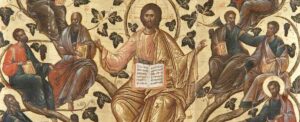Did you ever notice that the last feast of the Church year is the death and assumption of the Mother of God, and then the first feast of the Church year is her birth?
The September 1 indiction (which will come up in two weeks on our calendar) was a secular tax census before the Church began making it an occasion for prayers for the new year – so there’s no reason to assume the liturgical calendar was deliberately set up this way. But it is providential and appropriate!
Trivia – before Christ, the Roman year had only ten months. At the end of December was a “winter” which was simply off the calendar until March.
When January and February were added, they made the whole year part of the calendar but bumped months September through December to new positions where their names (7ember, 8ober, 9ember, 10ember) don’t make sense any more.
There’s evidence of the Romans inaugurating years in January or March, but the history of the Roman calendar is a disorderly snarl — and meanwhile the Egyptians had a complicated 13-month calendar until the Romans suppressed it.
In 537, Emperor Justinian decreed that all official acts had to relate to the annual tax survey (“indiction”) on September 1 so they could be dated precisely. The Church naturally adopted the same calendar.






